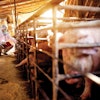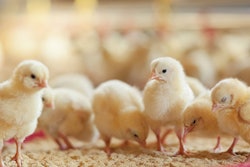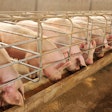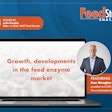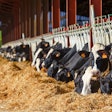Poultry feed sanitation is a key pillar of biosecurity programs
Feed can be a fomite for pathogens, which impact animal health and performance. To combat feed-source diseases, feed sanitation is used to reduce pathogenic bacteria loads in the gut. Compared with other feed hygiene options, true feed sanitizers reduce microbial loads in feed and protect feed against recontamination, ultimately preventing pathogen introduction and colonization in the gut.
Dr. Enrique Montiel, Anitox‘s director of nutrition and live production, joins the Chat to explore how feed sanitation can mitigate microbiome challenges during critical developmental windows in poultry production.
How feed-source pathogens impact poultry’s microbiome.mp4 from WATT Global Media on Vimeo.
Transcription of Feed Strategy Chat with Dr. Enrique Montiel, director of nutrition and live production, Anitox
Jackie Roembke, editor in chief, WATT Feed Brands/Feed Strategy: Hi, everyone. Welcome to Feed Strategy Chat. I’m your host, Jackie Roembke, editor in chief of WATT Feed Brands and Feed Strategy magazine.
This edition of Feed Strategy Chat is brought to you by WATT Global Media and FeedStrategy.com. FeedStrategy.com is your source for the latest news and leading-edge analysis of the global animal feed industry.
Today we are joined on Zoom by Dr. Enrique Montiel, the director of nutrition and live production at Anitox. He’s here to explore how feed-source pathogens can impact the microbiome.
Hi Dr. Montiel, how are you today?
Dr. Enrique Montiel, director of nutrition and live production, Anitox: Very well, thank you. Thank you for having me.
Roembke: Absolutely. Thank you for being here. Well, we’ll get right into it, then. How do feed-source pathogens impact the microbiome?
Montiel: We can take these across species, however, we talk specifically about poultry. When a chick hatches, then a race will start. The bacteria load of quote unquote, beneficial or not beneficial bacteria, that comes to the chicken is probably almost exclusively from the hen and is very limited. So it is the rest of the sources in the house that will contribute to, populate, that intestine and populate the microbiome in the chicken intestine. And one important source of these is is the feed.
Together with any bacteria load that can come into that intestine, there will be probably some feedback, some poultry pathogens, and also some beneficial bacteria. Probiotics are normally used in poultry production and those are desirable bacteria that you want to colonize that intestines.
What happens then is the competition starts right on, and the ultimate outcome of that colonization race to establish in the intestine, which will determine that that microbiome is balanced or is imbalanced. If the microbiome is imbalanced, then that will have a consequence to the chicken, normally a negative consequence to it. If we succeed to replicate beneficial bacteria, they will establish themselves and help excluding other harmful bacteria from the intestine.
Roembke: Very good. So does pathogen load affect the outcome or pose specific challenges to the health of the flock?
Montiel: Absolutely, I mean, there’s an important bacterial load that may come through feed. Feed is usually the consequence of mixing ingredients of various qualities and various sources geographically, and in the nature of the feed ingredient, the raw material itself, to make feed.
If we take all these into account, there’s always a chance that there will be an important bacteria load with the feed, but these will be variable, I mean, some sometimes it may be higher than than others. If you succeed in controlling these bacteria loads, or try to minimize these bacteria loads, the intestinal tract of the chicken will have a much better chance to reach a balance. And then as we said before, that we minimize the interference that the “good bacteria” will face from the rest of the bacteria load and, in not having to wrestle them, will have a better opportunity to establish themselves in the intestine and produce a positive consequence for the chickens.
Roembke: Will you please describe the role that feed sanitation can play in in fighting these pathogens and also improving productivity?
Montiel: If you think of feed and the way that feed circulates in a poultry operation, a batch of feed can reach a good part of your poultry population in no time. So your feed, or the control you can have in those bacteria loads in the feed, is a fundamental pillar in your biosecurity program.
When you think that it is an opportunity for pathogens to reach your chickens, and you think that way, for example, feed trucks come into farms where the truck is washed, maybe the driver will have to take a shower or change clothes or whatever, but there’s no change to the feed that is coming in the truck. So doing feed sanitation would help you as part of the poultry production engine to have some control, establish some interventions to control those bacterial or maybe viral loads that can come with a feed and cause a problem.
Roembke: Are there any considerations feed producers should take into account before introducing these solutions?
Montiel: If we’re talking about microbial loads — and this includes bacteria, includes mold and yeast, may include some viruses, depending on the case, there’s extensive literature, pieces of literature that show this — the No. 1 step for a producer would probably be to evaluate the risk that that bacterial population in the feed may pose to your operation and to the health of your animals.
The second one is in thinking of that risk, then to evaluate the potential effect that it can have in your chickens because the effects can be devastating. The combination of the two will define what interventions you need or you will like to have to minimize the impact of the feed potentially bringing pathogen into your commercial operation. If you have a good measurement, and the risk is well determined and the impact is well identified, that will naturally lead to a consequence. Define what your feed interventions should be, and how feed sanitation can help keep your operation healthy by keeping your chickens in the top production mode.
Roembke: Thank you for those insights, Dr. Montiel. If you’ll be in Bangkok for VIV Asia, join us on March 9 for the Feed Strategy Seminar, “How to improve monogastric gut health and immunity.” Here, Dr. Montiel will examine how the load and prevalence of feed-source pathogens impacts the microbiome.
For more information, visit www.feedstrategy.com/feed-strategy-events.
